The NSW Government’s Air program integrates air quality monitoring, forecasting and reporting to build a scientific evidence base for air quality management that reduces air pollution and protects communities. Our response to the NSW 2019–20 bushfires identified opportunities for continual improvements towards a better, more disaster-resilient future.
Key points
- The NSW Government operates Australia’s most extensive air quality monitoring network, with over 90 air quality monitoring stations providing the community with accurate, up-to-date information on an hourly basis.
- During the NSW 2019–20 bushfires, we deployed nine emergency air quality monitoring stations equipped with communications systems to regularly update data to the NSW Government air quality website.
- Our emergency air quality information services delivered hourly-updated data, health alerts and forecasts to inform NSW communities on air quality risk due to the impact of bushfires.
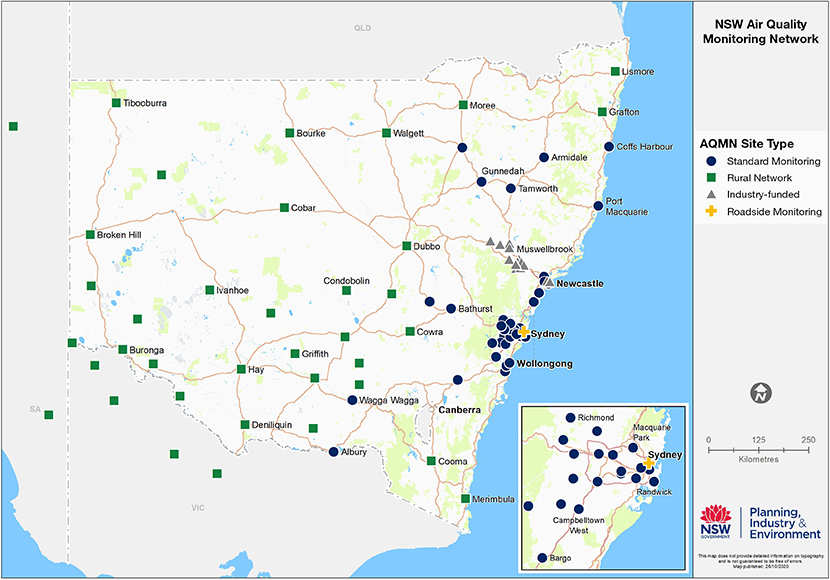
NSW Air Quality Monitoring Network, showing station types
More detail
Statewide air quality monitoring network
During the NSW 2019–20 bushfire period, more than 90 long-term air quality monitoring stations across the State provided communities, businesses and the Government with accurate, hourly updated air quality information.
The NSW Air Quality Monitoring Network(AQMN) includes stations across several integrated networks, monitoring a range of air quality and meteorological conditions.
- The standard monitoring network includes over 50 stations using compliance monitoring methods, including long-term monitoring stations, industry funded stations and research stations.
- The Rural Air Quality Monitoring Network includes over 30 long-term rural monitoring stations using indicative particle monitors, across northern, central and western New South Wales, extending into South Australia and Victoria (formerly the NSW Community DustWatch network).
- The AQMN also includes special purpose monitoring such as roadside air quality monitoring and air pollution incident monitoring.
Parameters monitored and instruments used may vary across networks and stations, depending on specific needs or monitoring objectives. In summary, the NSW AQMN continuously measures particles (PM10 and PM2.5), sulfur dioxide (SO2), carbon monoxide (CO), ozone (O3),nitrogen dioxide (NO2) and visibility (NEPH) due to air pollution. Meteorological monitoring includes wind speed and direction, air temperature, humidity, rainfall and solar radiation.
Deployment of bushfire monitoring stations
The NSW Government has established an air pollution emergency monitoring response capability for incidents lasting several days to many months. An emergency air quality monitoring station may be established within 24–48 hours of receiving a request from a leading emergency response agency. The capability has been deployed in response to multiple incidents since 2017, including the Chullora recycling station fire in 2017 and the Kooragang Island Waste Emplacement Facility underground fire in February to June 2019.
In response to the NSW 2019–20 bushfires, we deployed 9 emergency air quality monitors to locations near smoke-affected communities between July 2019 and January 2020.
- The first station was established at Port Macquarie on the Mid-North Coast in late July 2019 to monitor air quality impacts from an underground peat fire, which contributed to bushfires in the region.
- As the extent and intensity of the fires increased in north-eastern NSW, we deployed stations at Coffs Harbour and Taree on the Mid-North Coast and at Lismore and Grafton in the Northern Rivers region in November 2019.
- As major fires progressed further south along eastern NSW, stations were established on the South Coast in December 2019, at Batemans Bay and Ulladulla, and in January 2020, at Merimbula on the far South Coast and at Cooma in the Snowy Mountains.
Monitoring stations at Lismore, Grafton, Merimbula and Cooma were retained as part of the Rural Air Quality Monitoring Network after the bushfires were extinguished in mid-February 2020. Stations at Coffs Harbour and Port Macquarie have been retained as standard monitoring stations in the network.
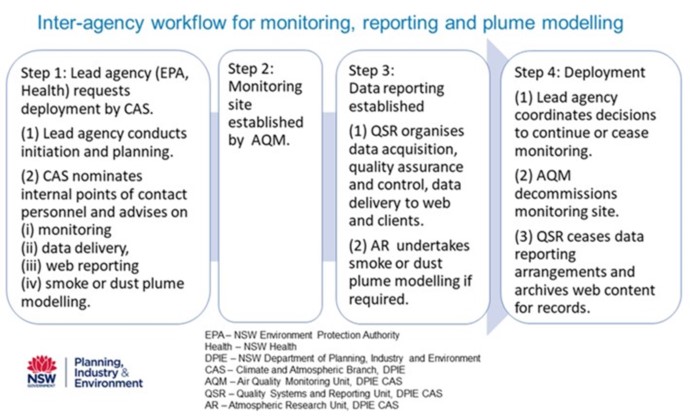
Air quality emergency interagency protocols. A request from a lead agency triggers a workflow for the deployment of emergency air quality monitoring, reporting and plume modelling.
Provision of air quality data, alerts, modelling and forecasts
The NSW Government provides air quality data and information to the public in various formats and through multiple channels. During air pollution incidents, we enhance our service delivery to meet the needs of communities and emergency response partners. Here we highlight our major services, accessed widely during the NSW 2019–20 bushfires.
- We published monitoring data and advice on our air quality data website to inform the public on current air quality and associated health risks.
- Hourly air quality data from the long-term and emergency air quality monitoring stations are reported online and updated in near real-time.
- The air quality website serviced up to 500,000 visits per week during the NSW 2019–20 bushfires. The most daily visits occurred on 10 December 2019 with over 208,000 unique page views.
- We improved our health guidance and advice during the NSW 2019–20 bushfire period to better inform the public on actions to minimise exposure to elevated air pollution
- We updated our data reporting to provide hourly-averaged particle measurements to inform the public on short-term air quality risks due to smoke from bushfires.
- We issued air quality alerts to inform communities and agencies about changes in air quality that may affect health. Our database delivers automated air quality alerts on high pollution events to our air quality website and to subscribers via SMS or email. On 29 February 2020, there were over 12,000 subscribers to the alert and forecast services, including over 8000 new subscribers from 1 September 2019 to 29 February 2020.
- We issued air quality forecasts to inform communities about air quality conditions expected for the following day. Daily air quality forecasts are issued routinely at around 4pm for the Sydney region, published online and delivered to subscribers via SMS or email. Forecasts are reviewed and updated if necessary, on the following morning. When air quality is forecast to be poor or worse, heath alert emails are automatically delivered to subscribers.
- We delivered additional forecasting information services during the bushfire emergency period.
- Air quality warnings for regional areas were posted online and delivered to public health and air quality management authorities via email.
- Multiple forecast reviews were conducted throughout each day in consultation with relevant agencies including NSW Health, NSW Environment Protection Authority (EPA), NSW Rural Fire Service (RFS), Fire and Rescue NSW (FRNSW) and the Bureau of Meteorology (BoM).
- We modelled air quality impacts of bushfire smoke and dust storms to support our air quality forecasting services. Our air quality and forecasting capability is based on advanced data processing tools that combine meteorology and chemical transport modelling systems.
- Major improvements were made in smoke emissions modelling and forecasting during the NSW 2019-20 bushfires to more accurately predict the smoke impacts on regional air quality from the extreme scale of the wildfires.
- Our air pollution trajectory and dispersion modelling system HYSPLIT in NSW has produced daily plume forecasts since July 2019.
- We distributed customised air quality data reports as required by emergency response authorities, incident controllers or affected businesses to address the specific needs of agency partners and local community service providers during bushfire emergency conditions.
- We provided special air quality notifications on the impacts of bushfires to government senior managers, fire management authorities and relevant agencies including NSW Health to ensure consistent air quality messaging and to facilitate public health management.
- We published an emergency air quality monitoring factsheet and regular media releases and participated in media broadcasts during the bushfire emergency period. This provided up to date advice on changing air quality conditions and available information services for smoke affected communities and service providers.
- We launched additional online data service tools that support customised delivery of current and historical air quality and meteorological data to response agencies, businesses and the public.
- Our data-download facility provides access to historical monitoring data in various formats.
- Our web-based Air Quality Application Programming Interface (API) allows web users to stream data for business and mobile applications.
- We supplemented our near real-time online information with regular air quality summary reports, published for a range of audiences.
- Monthly DustWatch reports provide information on dust risk for rural communities.
- Seasonal newsletters provide air quality summaries for communities in the Upper Hunter, Lower Hunter and the Namoi/North-west Slopes regions.
- Air pollution episode analyses provide detailed analysis of high pollution events across different regions.
- Annual Air Quality Statements summarise the state of air quality across New South Wales in each calendar year.
- Annual air quality compliance reports provide detailed assessment of NSW air quality monitoring data against national air quality standards.
Lessons learned and ongoing improvement
Our emergency response experience and subsequent program development are strengthening our emergency preparedness and building our capacity to contribute to a better, more disaster-resilient future.
- Community feedback during the NSW 2019–20 bushfire period demonstrated a need to improve our public information services. The NSW Government is working with jurisdictions, through the National Air Technical Advisory Group (NATAG), to ensure a nationally consistent approach to air quality data reporting and to deliver health information that is easier to understand. NATAG has endorsed the enHealth recommendation for hourly PM2.5 reporting and related health messaging.
- Our Enhanced website and air quality data delivery (EWADD) program, commissioned in 2019, is implementing a system for managing, reporting and delivering air quality data to meet changing business needs and customer expectations. A new website will deliver enhanced public-facing air quality data and information services and replace the data management and reporting system that has operated since 2008.
- Our Enhancing air quality forecasting in NSW program, incorporating an improved air emissions modelling system, is building our capability in assessing the impacts of significant pollution events including bushfires and dust storms.
- Our research on black carbon is improving our understanding of the sources of fine particle pollution. Black carbon is a major component of fine particle pollution in urban areas and has effects on urban air quality, public health and global climate. Sources include bushfires and the incomplete combustion of fuels used for transport, heating and industrial activities. We are using seven aethalometers to monitor black carbon at six air quality monitoring stations across metropolitan and regional areas.
- We are collaborating with leading research partners and environment agencies in other jurisdictions to design and deploy sensor networks for real-time air pollution mapping. Data from sensor networks will be integrated with high quality network monitoring data, regional airshed modelling and remote sensing information. This will be useful for investigating intra-urban mapping of air quality to gauge pollution levels in local communities and transport corridors, and for assessing the impact of smoke from bushfires and planned burns.
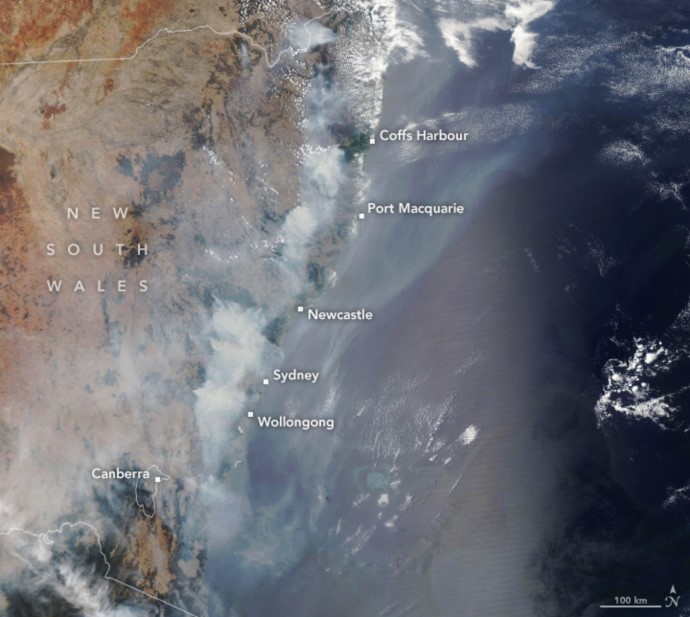
Satellite image of smoke from bushfires along NSW eastern ranges, 9 December 2019. During July to November 2019, five bushfire emergency air quality monitoring stations were deployed across the NSW Northern Rivers and Mid-North Coast regions, including Port Macquarie and Coffs Harbour.
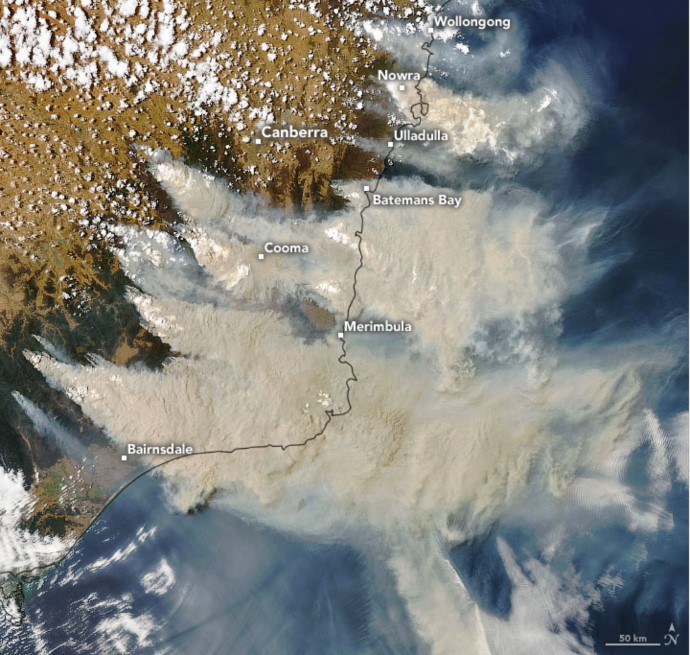
Satellite image of smoke from bushfires across NSW south-eastern ranges, 4 January 2020. In December 2019 to January 2020, four bushfire emergency indicative monitoring stations were established in the NSW south coast region at Ulladulla, Batemans Bay and Merimbula and at Cooma in the Snowy Mountains region.
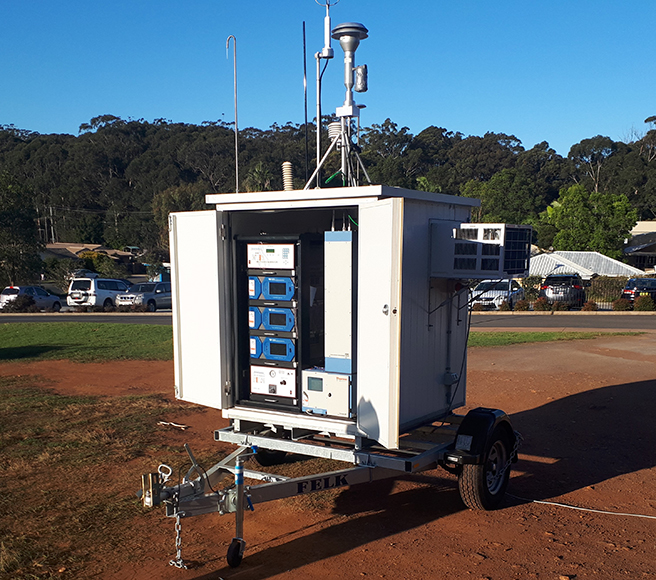
Air quality emergency interagency protocols. A request from a lead agency triggers a workflow for the deployment of emergency air quality monitoring, reporting and plume modelling.
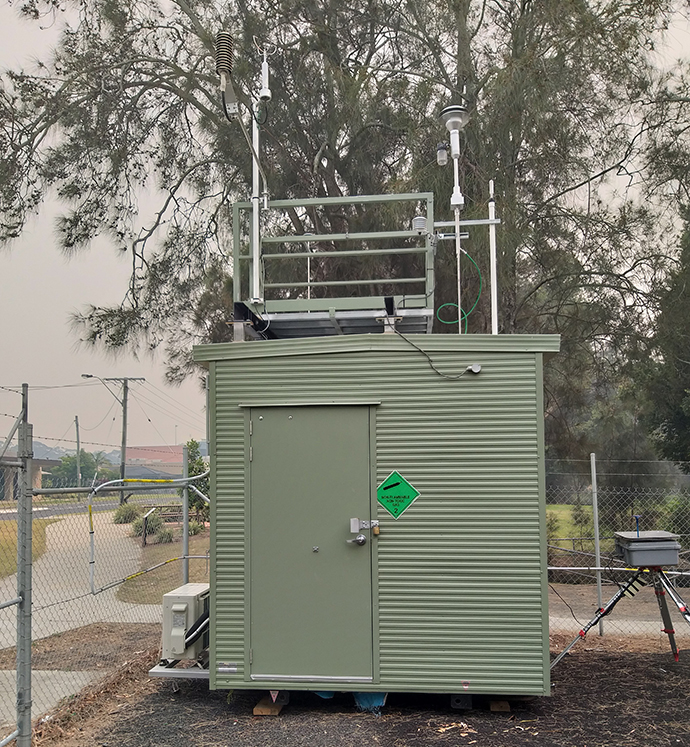
Bushfire emergency air quality standard monitoring station (left) and an indicative monitoring station (right), co-located at Coffs Harbour on the Mid-North Coast on 22 November 2019.
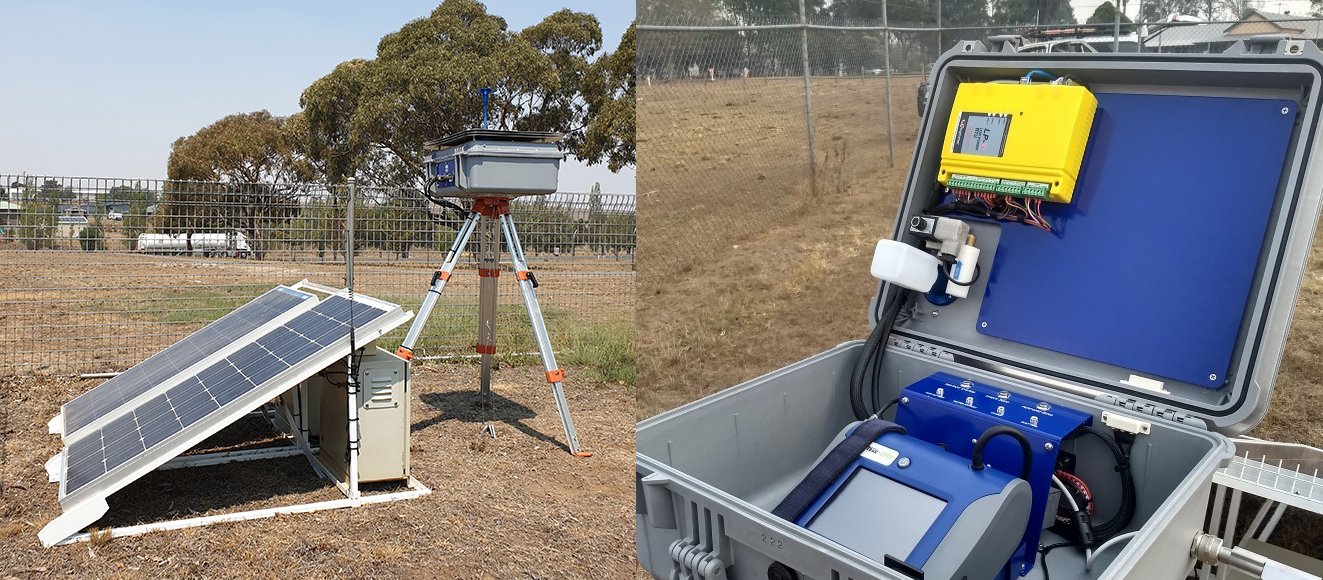
Bushfire emergency air quality indicative monitoring station, established at Cooma in the Snowy Mountains region on 13 January 2020. Similar indicative monitoring stations were established in the Northern Rivers at Grafton on 21 November 2019; on the Mid-North Coast at Taree on 22 November 2019; and on the South Coast at Ulladulla on 7 December 2019, Batemans Bay on 10 December 2019, and Merimbula on 12 January 2020. An indicative monitor was also co-located with a standard emergency monitoring station at Coffs Harbour on the Mid-North coast on 22 November 2019.